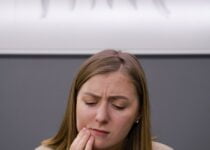Dental occlusion – Definition, Defects, What to do
Dental occlusion is how the upper teeth “mesh” with the lower teeth. We can thus say that it is about all the contacts occurring between the opposing teeth. These contacts are called “intercuspid contacts” because the masticatory face of each tooth is made up of grooves and cusps, a kind of protuberance found at the top.
 Dental occlusion: Normal occlusion
Dental occlusion: Normal occlusion
The “normal” occlusion corresponds to the position of “maximum intercuspidia”, in other words, the position where the cusps of the teeth prevent further closure of the teeth. This position is furtive in natural conditions: it is found in particular for a brief moment with each salivary swallowing (estimated at 1 per minute).
In the maximum intercuspid position, the lower teeth are ideally covered by the upper ones over a third or a quarter of their height. The molars and premolars, on the other hand, pile up.
This position constitutes the reference occlusal position, but it should not be confused with the “centred relation ” which constitutes the articular reference position. The latter is important because it makes it possible to have a mandibular reference position independent of the teeth (these can indeed fall with age). Unfortunately, this reference is controversial, not least because it is based more on clinical experience rather than scientific arguments, and tears up many schools of dentistry 1. It does not always correspond exactly with the reference occlusal position.
Classification of Angle of Occlusion
Although dating from the 19th century, the Angle classification which bears the name of its designer is still used by orthodontists. There are 3 different classes of occlusion cases:
– Class 1, which is the normal situation. The lower teeth are well offset, behind the upper ones, by half a cusp.
– Class 2, which is an abnormal situation. The lower teeth are too far back, a full cusp.
– Class 2, which is another abnormal situation. The lower teeth are too advanced compared to the upper ones. This usually induces prognathy and reverse occlusion.
This classification is always useful, but it has the drawback of not taking into account the defects of occlusion in the vertical direction and the lateral direction.
Malocclusions
There are several types of malocclusions depending on the direction you consider (vertical or front to back, for example).
- Incisor overbite. The upper incisors overlap the lower incisors too much.
- Incisor infraclusia . The upper incisors do not sufficiently cover the lower ones. If it is too marked, there is a gap .
- Molar supraclusia . The molars are too out.
- Molar infraclusy . The molars are not touching.
- Hiatus . The upper incisors are too far in front of the lower incisors.
- Cross occlusion . The lower teeth overlap the upper ones.
Risk factors for a occlusion
Wild or / and uncompensated extractions (edentations) . The loss of a tooth, extracted by a dentist or not, not replaced, leads to very unfortunate disturbances on the entire dental system. Its absence will cause a real imbalance of forces and will gradually disrupt the occlusion. Thus, a tooth which loses its antagonist will seek occlusal contact and, destabilized, will move freely in the space which is now offered to it. We speak of egression . This is one of the reasons why dentists insist on removing wisdom teeth in pairs. A tooth that loses its distal tooth will also migrate and tilt towards this free space. These new conformations are responsible for malocclusions and loosening of the teeth.
Atypical salivary swallowing . In this abnormal type of swallowing, the tongue comes between the dental arches. This interposition prevents contact between the opposing teeth and therefore does not cause any proprioceptive stimulation necessary for occlusal balance. It induces an insidious migration of teeth.
Bruxism . We call “bruxism”, the unwanted grinding or clenching of the teeth, apart from periods of chewing or swallowing. Such a disease affects children as well as adults, night and day. But it is at night that it poses the most problems, because the lack of any control increases the risk of violent shocks and significant dental friction. The premature wear of the teeth will gradually disrupt the occlusion.
Extractions of wisdom teeth, damaged teeth, dental surgeries are also additional risk factors.
The consequences of Dental occlusion
Malocclusions are likely, over time, to have various consequences on health:
– A deterioration of oral health
– The loosening of one or more teeth
– The imbalance of the posture (position of the hips, walking, position of the facial bones)
– Dysfunction of the temporomandibular joint (pain, crunches)
– Various pains (headaches, migraines, postural pain, etc.)
– Snoring, even sleep apnea.
– A deterioration of the general condition.
– Disturbed sleep.
You can see Also :


